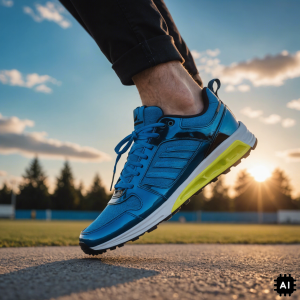


As a young athlete, the running sneakers you choose can significantly impact your performance on the track. Then there is the debate between running spikes vs running sneakers. Each option offers distinct advantages and considerations. This is why athletes must understand the differences before lacing up.
These pros and cons of running spikes and regular running sneakers will help track and field athletes have a better understanding of their running gear to make an informed decision.

Do I Need Running Spikes For Track?
Runners know that a sneaker is a sneaker—even though these aren’t created equal. Sneakers designed especially for runners help with performance when it comes to specs like how lightweight it is, their arch support, and cushioning.
Running spikes, also known as track spikes or cleats, are specialized shoes designed for track and field events, particularly sprinting, middle-distance running, and jumping.
Whether youth or seasoned runners need spikes depends on several factors, including the type of events they participate in, the surfaces they compete on, and their personal preferences.
Here are some considerations:
Events
Spikes can offer advantages including traction, grip, and performance at track meets.
Track Surface
Spikes are designed primarily for rubberized or synthetic tracks commonly found in many high school track and field facilities. If the track surface is dirt, grass, or another uneven terrain, spikes may not be necessary or suitable.
Coach Recommendations
Coaches often guide on the appropriate footwear for their athletes based on the events they specialize in and track conditions. Don’t purchase a pair before asking if on a team.
Preference
Some high school runners may prefer the feel and performance benefits of spikes, while others may find them uncomfortable or unnecessary. Factors such as foot anatomy, running technique, and individual comfort levels can influence whether spikes are suitable for a particular athlete.
Running Spikes vs. Running Sneakers

They have several key differences when comparing spikes vs. regular running shoes.
Design
Running spikes are equipped with a spike plate on the bottom of the sole. It is made of plastic or metal, with spikes protruding from it. These spikes provide traction and grip on the track surface, especially during sprinting and turning.
Spikes are typically lighter than regular running shoes. This lightweight design minimizes excess weight and allows athletes to move more efficiently, particularly during sprinting events where every ounce can make a difference in performance.
Cushion
Unlike regular running shoes, which often have ample cushioning for shock absorption, spikes have minimal cushioning. This design feature reduces the weight of the shoe and allows for a more direct connection between the foot and the track, enhancing speed and agility.
Specificity
Running spikes are designed for specific track and field events. Sprinting spikes have fewer spikes (around 6-8) and a more aggressive spike plate. This provides more traction for explosive starts and when accelerating.
Middle-distance spikes may have more padding and support.
Jumping spikes are generally wider and have more hell support for landing and takeoff.
Running Sneakers
Regular running shoes are designed for everyday running on various surfaces, including roads, trails, and tracks. They typically offer more cushioning and support for comfort during longer runs, as well as features like pronation control and arch support to accommodate different foot types and running styles.
Any sneaker works fine for meets, but it’s important that sneakers fit properly. Some sneakers are designed to be more lightweight for sprinters, have more traction than other pairs, and can help with footstrike.
Conclusion
The decision to use spikes vs running sneakers should be based on the specific needs and circumstances of runner. While spikes can offer advantages in certain situations, they are not essential for every athlete or every event.










No comments so far.
Be first to leave comment below.